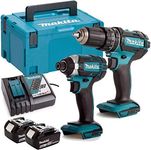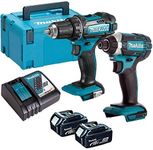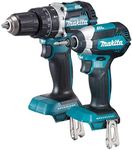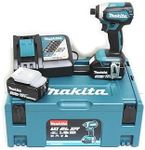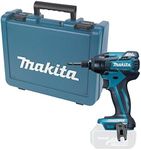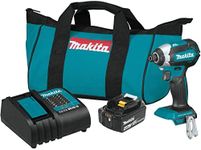Buying Guide for the Best Makita Impact Drivers
When choosing an impact driver, it's important to consider the tasks you plan to tackle and the features that will best support those tasks. Impact drivers are powerful tools designed to drive screws and bolts with high torque, making them ideal for heavy-duty applications. Understanding the key specifications will help you select a model that fits your needs, whether you're a professional tradesperson or a DIY enthusiast.TorqueTorque is the rotational force that the impact driver can apply. It's crucial because it determines the tool's ability to drive screws and bolts into tough materials. Torque is usually measured in inch-pounds (in-lbs) or Newton-meters (Nm). Lower torque (around 800-1000 in-lbs) is suitable for light tasks like assembling furniture, while higher torque (over 1500 in-lbs) is better for heavy-duty tasks like driving large screws into hardwood. Consider the materials and types of fasteners you'll be working with to choose the right torque level.
Speed (RPM)Speed, measured in revolutions per minute (RPM), indicates how fast the driver can rotate. This is important for efficiency and control. Lower speeds (around 1000 RPM) are better for precision work, while higher speeds (up to 3000 RPM) are ideal for quickly driving screws. Many impact drivers offer variable speed settings, allowing you to adjust the speed based on the task. If you need versatility, look for a model with multiple speed settings.
Impacts Per Minute (IPM)Impacts Per Minute (IPM) measures how many times the driver delivers its hammering action in a minute. This is important for driving screws into hard materials. A higher IPM (over 3000) means the tool can handle tougher jobs more efficiently. If you frequently work with dense materials, a higher IPM will be beneficial. For general use, a moderate IPM should suffice.
Battery VoltageBattery voltage affects the power and runtime of cordless impact drivers. Common voltages are 12V, 18V, and 20V. Lower voltage models (12V) are lighter and more compact, suitable for light-duty tasks and tight spaces. Higher voltage models (18V or 20V) provide more power and are better for heavy-duty applications. Consider the balance between power needs and tool weight/size when choosing the voltage.
Chuck SizeThe chuck size determines the maximum diameter of the bit that can be used with the driver. Most impact drivers have a 1/4-inch hex chuck, which is standard for most driving tasks. This size is compatible with a wide range of bits. If you need to use larger bits, ensure the driver can accommodate them, but for most users, a 1/4-inch chuck will be sufficient.
Weight and ErgonomicsThe weight and ergonomics of an impact driver affect user comfort, especially during extended use. Lighter models are easier to handle and reduce fatigue, which is important if you'll be using the tool for long periods. Ergonomic designs with comfortable grips can also enhance control and reduce strain. Consider how long and how often you'll use the tool to determine the importance of these factors.



